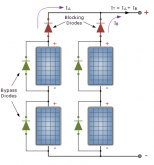Thanks for your reply Rider. I've spent more time searching online. Here's what I think I'm going to do.
1. Breaker Polarity. I've found two other sources that agree with your opinion that I consider the pv panels my "source" for wiring to the breaker. That is, the pv panel positive will be connected to the "Bat/Line" breaker terminal. Why am I considering breakers rather than switches? I guess, why not. I estimate my wire run from pv panel to controller to be about 25'-35' one way. I strikes me as a fair amount of wire to run without protection, and the price difference between switch and breaker isn't important to me.
2. Breaker Location. Because of the wire length and assuming I'm protecting the wires from the pv panel, I now plan to locate the breakers closer to the panels. I'll have a protected and accessible location, at the aft end of the boat where the wires will enter hull, to install the breakers. It's also where my shore power enters the hull, also with a circuit breaker at that location. If I suspect electrical overheating, I like the idea of exiting the boat to reach a single location where I can disconnect the AC and pv panels. (I'm still thinking through battery bank disconnects.)
3. 3 Controllers. A controller for each panel is a common recommendation for sailboats. Sailboats are plagued by shadows from spars, rigging and sails. Individual controllers are purported to maximize the energy produced. Because each controller is smaller and cheaper than a single larger controller, the additional cost for individual controllers wasn't brutal. Of course, I'll be buying and installing more wire and connectors.
4. Isolator/Diode. I haven't read of that suggestion elsewhere. My understanding is that a charger and solar can be used at the same time without any isolation. But, you've piqued my curiosity, and I'll research this more. Thanks for that suggestion.
I also sent my questions to my panel provider and to a professional installer. I'll update this forum if I receive any different suggestions from those two sources.




